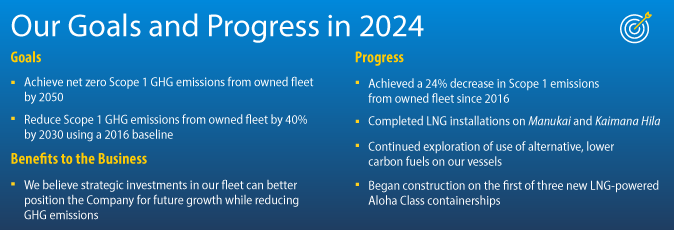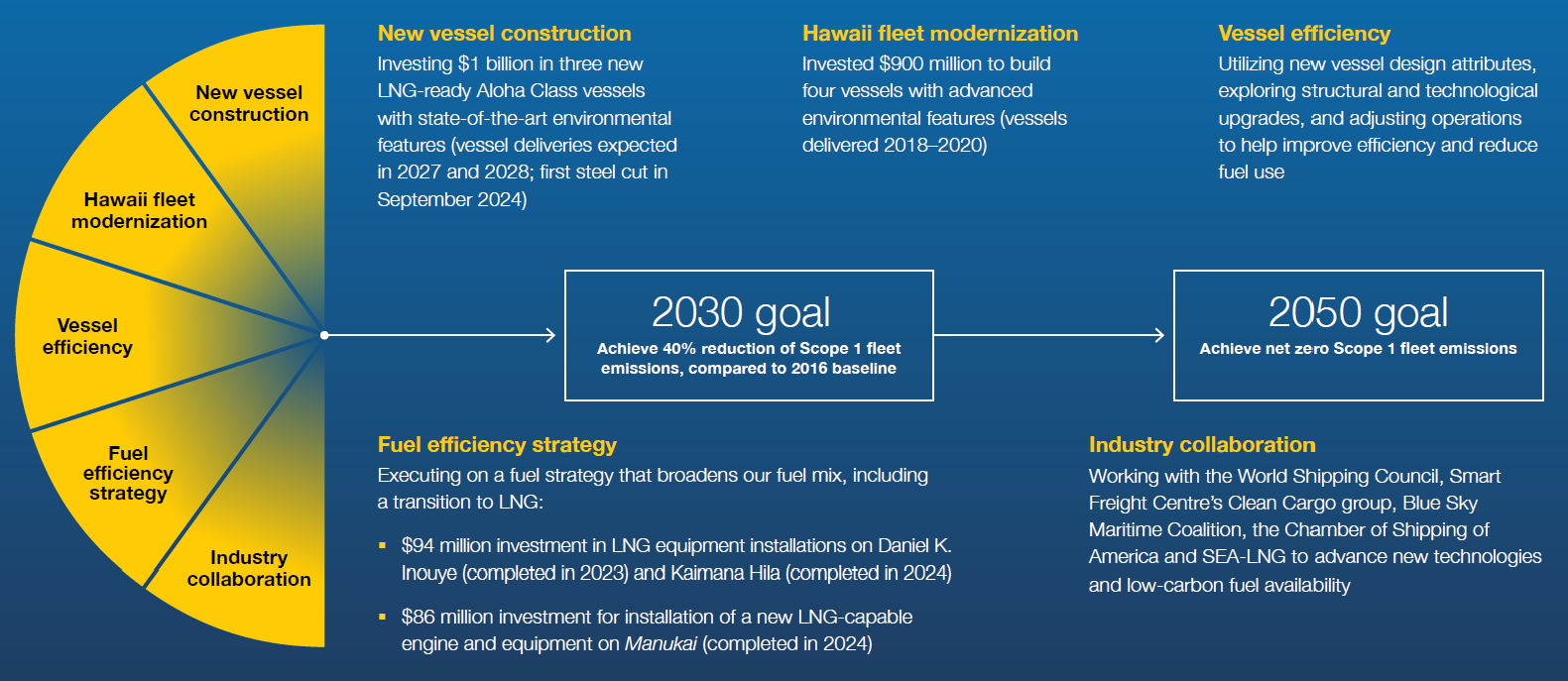
Environmental Stewardship
Environmental Stewardship
Being a leader in environmental stewardship is one of Matson’s core values. Our vessels transit some of the most environmentally sensitive areas in the U.S., including the Hawaiian Islands and the coasts of California, Oregon, Washington, and Alaska. In particular, we are focused on reducing transportation emissions through investments in technology, improvements in vessel fuel consumption, choice of fuel type, and the development of more fuel-efficient transportation solutions.
Climate Change and GHG Emissions
Matson’s climate adaptation strategy is designed to help us identify, assess and mitigate climate-related risks (both physical and transitional), evaluate climate-related opportunities and increase the resilience of our operations. We have designed a risk identification and mitigation process to assess and prioritize climate risks with significant impacts to our operations. These efforts are balanced against Matson’s focus on maintaining vessel schedule integrity and the reliability of our ocean transportation and logistics operations and delivering high-quality services to all our customers.
We have set an interim goal to achieve a 40% reduction in Scope 1 GHG emissions from our owned fleet by 2030, measured against a 2016 baseline, and a longer-term goal to achieve net zero Scope 1 emissions from our owned fleet by 2050.

Our Climate Transition Plan
Establishing a plan to help us achieve our 2030 and 2050 decarbonization goals begins with assessing our exposure to climate risks and opportunities. This helps us understand our current progress toward emissions reduction targets, prioritize key risks, and determine where to focus our efforts. These periodic sustainability assessments and regular risk reviews also help us identify where to invest our resources. Our current investments are focused on technology and efficiency upgrades, including building new state-of-the-art vessels, modernizing our existing fleet and executing on our fuel strategy. We are also collaborating within our industry to advance development of new, lower-carbon fuel solutions. Other aspects of our Climate Transition Plan include:


Air Emissions
Managing air pollutants is important for the ocean shipping industry as emissions of these pollutants may negatively impact human health and the environment. We employ various methods to help reduce our air emissions. Lurline, Matsonia and most recently, Manukai, all have Tier 3 engines that emit approximately 80% less nitrogen oxide emissions compared to Tier 1 engines, making these vessels among the lowest emitting deep-sea vessels to regularly call the U.S. West Coast. We plan to install Tier 3 engines on our three new Aloha Class vessels. We also regularly use AMP shore power in California and China, and rely on vessel emissions capture and control barges in California to reduce air emissions from vessels while they are in port.
Energy Use and Alternative Fuels
Over the past several years, we have committed significant resources to enable the use of LNG and other alternative fuels on our vessels. We continue to assess the impact of these fuels on Our Climate Transition Plan and broader business model. Beyond the fuels we use to power our vessels, we are also exploring technology and efficiency upgrades designed to further reduce the impact of our operations on the environment.
Ocean Health and Biodiversity
Our oceans are a vital natural and economic resource that support the livelihoods of billions of people, play a critical role in the carbon cycle, and help regulate the global climate. We strive to minimize our impact on the marine environment and safeguard our seas for future generations.
Explore More
For more information, please see our latest Sustainability Report and overview of our Environmental Stewardship Program.
- LEED-certified buildings
